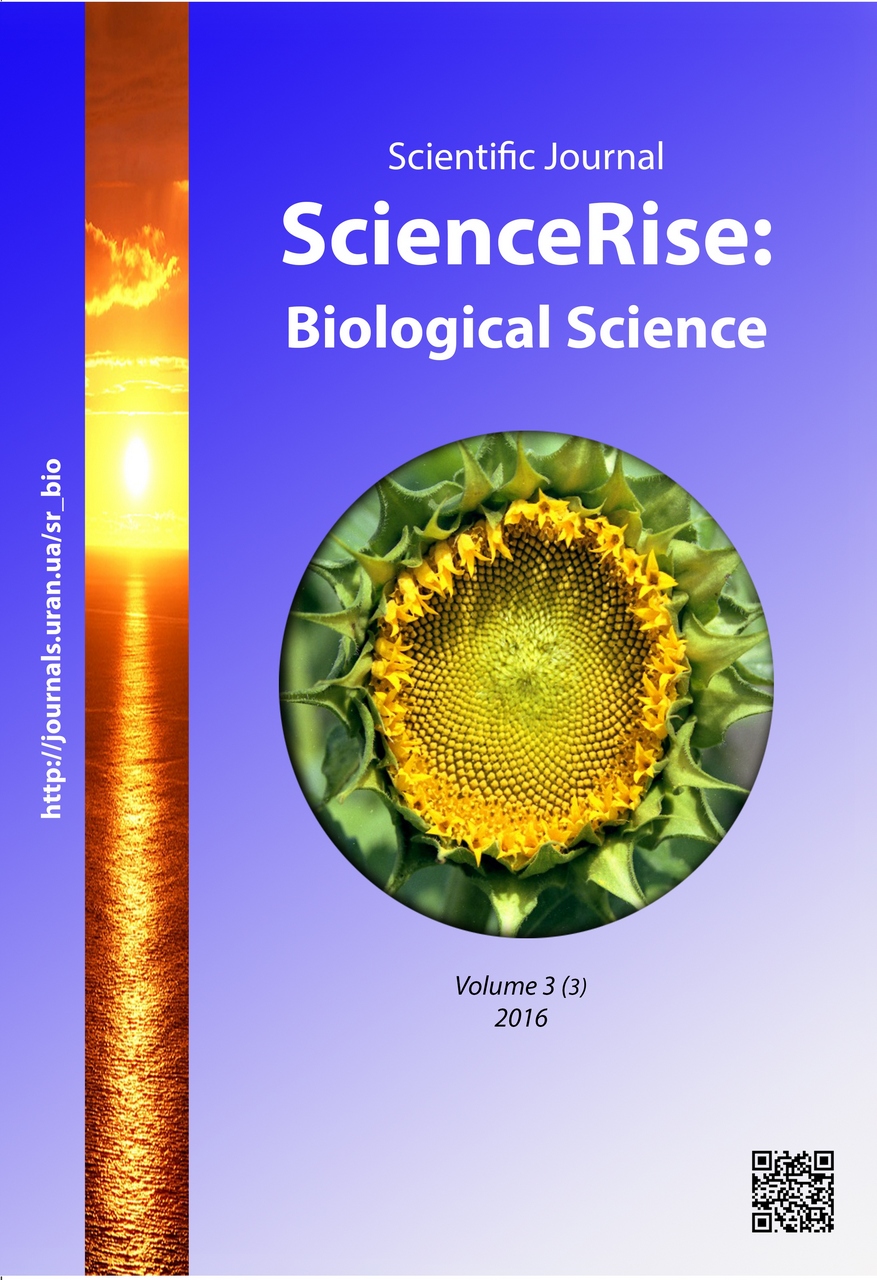Antifungal influence of culture fluid of melanin producer Pseudonadsoniella brunnea
DOI:
https://doi.org/10.15587/2519-8025.2016.83675Keywords:
Antarctic microorganisms, Fusarium oxysporum, antagonism, fungicidal effectAbstract
The influence of culture fluid of melanin producer Pseudonadsoniella brunnea (Antarctic yeast-like fungus) on fungi of the genus Fusarium is studied. Stable fungicidal effect of culture fluid of Ps. brunnea on pathogenic fungi is revealed using agar diffusion method (or hole method). It is determined that the diameter of the zones of growth absence of test cultures of pathogenic fungi, those testified the fungicidal impact of Ps. brunnea, is similar to the action of biocides belonging to the class of quaternary ammonium compounds (benzalkonium chloride)
References
- Borrero, C., Trillas, M. I., Delgado, A., Avilés, M. (2011). Effect of ammonium/nitrate ratio in nutrient solution on control of Fusarium wilt of tomato by Trichoderma asperellum T34. Plant Pathology, 61 (1), 132–139. doi: 10.1111/j.1365-3059.2011.02490.x
- El-Hasan, A., Walker, F., Buchenauer, H. (2008). Trichoderma harzianumand its Metabolite 6-Pentyl-alpha-pyrone Suppress Fusaric Acid Produced byFusarium moniliforme. Journal of Phytopathology, 156 (2), 79–87. doi: 10.1111/j.1439-0434.2007.01330.x
- Kolombet, L. V. (2012). Biotehnologicheskie problemy sozdanija preparatov dlja rastenievodstva na osnove gribov roda Trichoderma. Prikladnaja toksikologija, 3 (1), 48.
- Maslichenko, L. V., Kurilova, D. A., Mahonin, V. L. (2011). Vlijanie mikrobiopreparatov na osnove perspektivnyh shtammov antagonistov vozbuditelej fuzarioza na kul'turu soi v polevyh uslovijah. Maslichnye kul'tury, 2, 145–148.
- Tkalenko, G. M., Sergijenko, V. G. (2012). Optymizacija zahystu ovochevyh kul'tur v Lisostepu Ukrai'ny. Karantyn i zahyst roslyn, 3, 9–14.
- Castano, R., Borrero, C., Trillas, M. I., Aviles, M. (2012). Selection of biological control agents against tomato Fusarium wilt and evaluation in greenhouse conditions of two selected agents in three growing media. BioControl, 58 (1), 105–116. doi: 10.1007/s10526-012-9465-z
- Cerkauskas, R. F., Brown, J., Ferguson, G. (2001). First Report of Fusarium Stem and Root Rot of Greenhouse Cucumber Caused by Fusarium oxysporum f. sp. radicis-cucumerinum in Ontario. Plant Disease, 85 (9), 1028–1028. doi: 10.1094/pdis.2001.85.9.1028a
- Yang, X., Chen, L., Yong, X., Shen, Q. (2010). Formulations can affect rhizosphere colonization and biocontrol efficiency of Trichoderma harzianum SQR-T037 against Fusarium wilt of cucumbers. Biology and Fertility of Soils, 47 (3), 239–248. doi: 10.1007/s00374-010-0527-z
- Kostadinova, N., Krumova, E., Tosi, S., Pashova, Angelova, M. (2009). Isolation and Identification of Filamentous Fungi from Island Livingston, Antarctica. Biotechnology & Biotechnological Equipment, 23, 267–270. doi: 10.1080/13102818.2009.10818416
- Svahn, K. S., Chryssanthou, E., Olsen, B., Bohlin, L., Göransson, U. (2015). Penicillium nalgiovense Laxa isolated from Antarctica is a new source of the antifungal metabolite amphotericin B. Fungal Biology and Biotechnology, 2 (1). doi: 10.1186/s40694-014-0011-x
- Kondratiuk, T. O., Morgaienko, O. O., Beregova, T. V., Ostapchenko, L. I. (2015). Peculiarities of Antarctic microorganisms and perspectives of their usage in biotechnology and medicine. Antarctic research: new horizons and priorities. Kyiv, Ukraine, 57–59.
- Golyshkin, D., Bychko, A., Beregova, T., Falalyeyeva, T. (2014). Influence of melanin on electrical characteristics of model bilipid membranes (in vitro). Bulletin of Taras Shevchenko national university of Kyiv, 66 (1), 90–92.
- Taburets, O. V., Morgaienko, O. O., Kondratiuk, T. O., Beregova, T. V., Ostapchenko, L. I. (2016). The effect of "Melanin-Gel" on the wound healing. J. Pharm. Chem. Biol. Sci., 7 (3), 2031–2038.
- Kondratyuk, T. O., Kondratyuk, S. Y., Morgaienko, O. O., Khimich, M. V., Beregova, T. V., Ostapchenko, L. I. (2015). Pseudonadsoniella brunnea (Meripilaceae, Agaricomycotina), a new brown yeast-like fungus producing melanin from the Antarctic; with notes on nomenclature and type confusion of Nadsoniella nigra. Acta Botanica Hungarica, 57 (3-4), 291–320. doi: 10.1556/034.57.2015.3-4.5
Downloads
Published
How to Cite
Issue
Section
License
Copyright (c) 2016 Тетяна Олексіївна Кондратюк, Тетяна Володимирівна Берегова, Людмила Іванівна Остапченко

This work is licensed under a Creative Commons Attribution 4.0 International License.
Our journal abides by the Creative Commons CC BY copyright rights and permissions for open access journals.
Authors, who are published in this journal, agree to the following conditions:
1. The authors reserve the right to authorship of the work and pass the first publication right of this work to the journal under the terms of a Creative Commons CC BY, which allows others to freely distribute the published research with the obligatory reference to the authors of the original work and the first publication of the work in this journal.
2. The authors have the right to conclude separate supplement agreements that relate to non-exclusive work distribution in the form in which it has been published by the journal (for example, to upload the work to the online storage of the journal or publish it as part of a monograph), provided that the reference to the first publication of the work in this journal is included.









